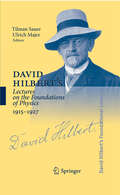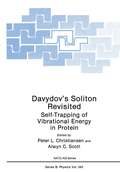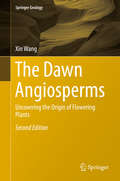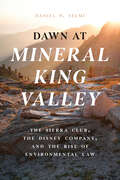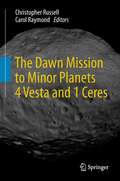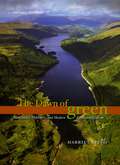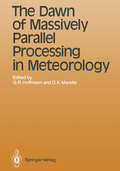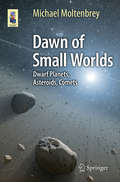- Table View
- List View
David Harvey's Geography (Routledge Library Editions: Social and Cultural Geography)
by John L. PatersonThe emphasis of this book is to explore two major philosophical influences in contemporary human geography, namely logical positivism and Marxism, and to explore the relationships between philosophy, methodology and geographical research. Rather than being a biography of David Harvey, the book contributes to the understanding of one of the most innovative and iconoclastic scholars in contemporary Anglo-American human geography.
David Hilbert and the Axiomatization of Physics: From Grundlagen der Geometrie to Grundlagen der Physik (Archimedes #10)
by L. CorryDavid Hilbert (1862-1943) was the most influential mathematician of the early twentieth century and, together with Henri Poincaré, the last mathematical universalist. His main known areas of research and influence were in pure mathematics (algebra, number theory, geometry, integral equations and analysis, logic and foundations), but he was also known to have some interest in physical topics. The latter, however, was traditionally conceived as comprising only sporadic incursions into a scientific domain which was essentially foreign to his mainstream of activity and in which he only made scattered, if important, contributions. Based on an extensive use of mainly unpublished archival sources, the present book presents a totally fresh and comprehensive picture of Hilbert’s intense, original, well-informed, and highly influential involvement with physics, that spanned his entire career and that constituted a truly main focus of interest in his scientific horizon. His program for axiomatizing physical theories provides the connecting link with his research in more purely mathematical fields, especially geometry, and a unifying point of view from which to understand his physical activities in general. In particular, the now famous dialogue and interaction between Hilbert and Einstein, leading to the formulation in 1915 of the generally covariant field-equations of gravitation, is adequately explored here within the natural context of Hilbert’s overall scientific world-view. This book will be of interest to historians of physics and of mathematics, to historically-minded physicists and mathematicians, and to philosophers of science.
David Hilbert's Lectures on the Foundations of Physics 1915-1927: Relativity, Quantum Theory and Epistemology
by Arne Schirrmacher Heinz-Jürgen SchmidtThese documents do nothing less than bear witness to one of the most dramatic changes in the foundations of science. The book has three sections that cover general relativity, epistemological issues, and quantum mechanics. This fascinating work will be a vital text for historians and philosophers of physics, as well as researchers in related physical theories.
Davydov’s Soliton Revisited: Self-Trapping of Vibrational Energy in Protein (Nato Science Series B: #243)
by Peter L. Christiansen Alwyn C. ScottProceedings of a NATO ARW held in Thisted, Denmark, July 30-August 5, 1989
The Dawn Angiosperms: Uncovering the Origin of Flowering Plants (Springer Geology #121)
by Xin WangThis book discusses the controversial and conflicting hypotheses on the origin of angiosperms, which was generally assumed to be restricted to the Cretaceous and later ages. Since publishing the first edition of “The Dawn of Angiosperms” in 2010, several important advances have been made in this field of science, namely 1) the discovery of new fossil angiosperms from the Jurassic; 2) European researchers discovering angiosperm-like pollen from the Triassic; and most importantly 3) the discovery of a perfect flower from the Jurassic. All of these findings are at odds with the currently widely accepted evolutionary theories, and thus call upon us to critically reassess botanical theory. Accordingly, the new edition of this book not only includes more new fossil taxa, but also documents them in greater detail and corrects many commonly held misconceptions. In so doing, it makes related studies and teaching on the early history of angiosperms more realistic, concrete, and tangible, providing concrete fossil evidence as the basis for future research, and helping to distinguish the most accurate botanical hypotheses.
The Dawn Angiosperms: Uncovering the Origin of Flowering Plants (Lecture Notes in Earth Sciences #121)
by Xin WangAngiosperms are the most diversi ed plant group in the world, being represented by ca 300,000 species in about 400 families. Like all of Life, including ourselves, they have had their own history and gone through many evolutionary stages before they arrived at their current forms. The origin of Angiospermae ( owering plants) has been the subject of much dispute because this is a key event in the history of life, and has a far-reaching in uence on our understanding of relationships among seed plants as a whole as well as within the angiosperms. Until recently most of palae- otanists recognized angiosperms only from the Cretaceous and younger strata. This contradicts the results of molecular analyses. I have been working on Mesozoic fossil plants for the past two decades, during which time I have studied a number of fossil plants. Some of these fossil plants have been published as Jurassic angiosperms, and, unsurprisingly, many questions and doubts have been raised about them. These questions need to be addressed se- ously and journal papers do not provide suf cient space to compare and relate these early angiosperms. In this book these pioneer angiosperms are documented in detail, sometimes with new specimens not studied before. Also, I propose a de nition of angiosperms that could be adopted in palaeobotany. My aim is to improve clarity and objectivity of judgment about what constitutes a fossil angiosperm.
Dawn at Mineral King Valley: The Sierra Club, the Disney Company, and the Rise of Environmental Law
by Daniel P. SelmiThe story behind the historic Mineral King Valley case, which reveals how the Sierra Club battled Disney’s ski resort development and launched a new environmental era in America. In our current age of climate change–induced panic, it’s hard to imagine a time when private groups were not actively enforcing environmental protection laws in the courts. It wasn’t until 1972, however, that a David and Goliath–esque Supreme Court showdown involving the Sierra Club and Disney set a revolutionary legal precedent for the era of environmental activism we live in today. Set against the backdrop of the environmental movement that swept the country in the late 1960s and early 1970s, Dawn at Mineral King Valley tells the surprising story of how the US Forest Service, the Disney company, and the Sierra Club each struggled to adapt to the new, rapidly changing political landscape of environmental consciousness in postwar America. Proposed in 1965 and approved by the federal government in 1969, Disney’s vast development plan would have irreversibly altered the practically untouched Mineral King Valley, a magnificently beautiful alpine area in the Sierra Nevada mountains. At first, the plan met with unanimous approval from elected officials, government administrators, and the press—it seemed inevitable that this expanse of wild natural land would be radically changed and turned over to a private corporation. Then the scrappy Sierra Club forcefully pushed back with a lawsuit that ultimately propelled the modern environmental era by allowing interest groups to bring litigation against environmentally destructive projects. An expert on environmental law and appellate advocacy, Daniel P. Selmi uses his authoritative narrative voice to recount the complete history of this revolutionary legal battle and the ramifications that continue today, almost 50 years later.
Dawn at Mineral King Valley: The Sierra Club, the Disney Company, and the Rise of Environmental Law
by Daniel P. SelmiThe story behind the historic Mineral King Valley case, which reveals how the Sierra Club battled Disney’s ski resort development and launched a new environmental era in America. In our current age of climate change–induced panic, it’s hard to imagine a time when private groups were not actively enforcing environmental protection laws in the courts. It wasn’t until 1972, however, that a David and Goliath–esque Supreme Court showdown involving the Sierra Club and Disney set a revolutionary legal precedent for the era of environmental activism we live in today. Set against the backdrop of the environmental movement that swept the country in the late 1960s and early 1970s, Dawn at Mineral King Valley tells the surprising story of how the US Forest Service, the Disney company, and the Sierra Club each struggled to adapt to the new, rapidly changing political landscape of environmental consciousness in postwar America. Proposed in 1965 and approved by the federal government in 1969, Disney’s vast development plan would have irreversibly altered the practically untouched Mineral King Valley, a magnificently beautiful alpine area in the Sierra Nevada mountains. At first, the plan met with unanimous approval from elected officials, government administrators, and the press—it seemed inevitable that this expanse of wild natural land would be radically changed and turned over to a private corporation. Then the scrappy Sierra Club forcefully pushed back with a lawsuit that ultimately propelled the modern environmental era by allowing interest groups to bring litigation against environmentally destructive projects. An expert on environmental law and appellate advocacy, Daniel P. Selmi uses his authoritative narrative voice to recount the complete history of this revolutionary legal battle and the ramifications that continue today, almost 50 years later.
Dawn-Dusk Asymmetries in Planetary Plasma Environments (Geophysical Monograph Series #230)
by Stein Haaland Andrei Runov Colin ForsythDawnDusk Asymmetries in Planetary Plasma Environments Dawn-dusk asymmetries are ubiquitous features of the plasma environment of many of the planets in our solar system. They occur when a particular process or feature is more pronounced at one side of a planet than the other. For example, recent observations indicate that Earth's magnetopause is thicker at dawn than at dusk. Likewise, auroral breakups at Earth are more likely to occur in the pre-midnight than post-midnight sectors. Increasing availability of remotely sensed and in situ measurements of planetary ionospheres, magnetospheres and their interfaces to the solar wind have revealed significant and persistent dawn-dusk asymmetries. As yet there is no consensus regarding the source of many of these asymmetries, nor the physical mechanisms by which they are produced and maintained. Volume highlights include: A comprehensive and updated overview of current knowledge about dawn-dusk asymmetries in the plasma environments of planets in our solar system and the mechanisms behind them Valuable contributions from internationally recognized experts, covering both observations, simulations and theories discussing all important aspects of dawn-dusk asymmetries Space weather effects are caused by processes in space, mainly the magnetotail, and can be highly localized on ground. Knowing where the source, i.e., where dawn-dusk location is will allow for a better prediction of where the effects on ground will be most pronounced Covering both observational and theoretical aspects of dawn dusk asymmetries, Dawn-Dusk Asymmetries in Planetary Plasma Environments will be a valuable resource for academic researchers in space physics, planetary science, astrophysics, physics, geophysics and earth science.
Dawn-Dusk Asymmetries in Planetary Plasma Environments (Geophysical Monograph Series #230)
by Stein Haaland Andrei Runov Colin ForsythDawnDusk Asymmetries in Planetary Plasma Environments Dawn-dusk asymmetries are ubiquitous features of the plasma environment of many of the planets in our solar system. They occur when a particular process or feature is more pronounced at one side of a planet than the other. For example, recent observations indicate that Earth's magnetopause is thicker at dawn than at dusk. Likewise, auroral breakups at Earth are more likely to occur in the pre-midnight than post-midnight sectors. Increasing availability of remotely sensed and in situ measurements of planetary ionospheres, magnetospheres and their interfaces to the solar wind have revealed significant and persistent dawn-dusk asymmetries. As yet there is no consensus regarding the source of many of these asymmetries, nor the physical mechanisms by which they are produced and maintained. Volume highlights include: A comprehensive and updated overview of current knowledge about dawn-dusk asymmetries in the plasma environments of planets in our solar system and the mechanisms behind them Valuable contributions from internationally recognized experts, covering both observations, simulations and theories discussing all important aspects of dawn-dusk asymmetries Space weather effects are caused by processes in space, mainly the magnetotail, and can be highly localized on ground. Knowing where the source, i.e., where dawn-dusk location is will allow for a better prediction of where the effects on ground will be most pronounced Covering both observational and theoretical aspects of dawn dusk asymmetries, Dawn-Dusk Asymmetries in Planetary Plasma Environments will be a valuable resource for academic researchers in space physics, planetary science, astrophysics, physics, geophysics and earth science.
The Dawn Mission to Minor Planets 4 Vesta and 1 Ceres
by Christopher Russell Carol RaymondDawn is the first mission to orbit a main belt asteroid and the first scientific mission to use ion propulsion. Major objectives of this mission include mapping of the surfaces of 4 Vesta and 1 Ceres, determining its topography from stereo measurements, determining its mineralogy, measuring its elemental composition and obtaining gravity data. This book describes the Dawn mission, its exploration and scientific objectives, the instruments that accomplish those objectives, the operations plan and the education and outreach plan. It is directed to those studying asteroids and the evolution of the solar system. This volume will be a valuable reference for anyone who uses data from the instruments of the DAWN mission. Previously published in Space Science Reviews, Vol. 163/1-4, 2012.
The Dawn of Green: Manchester, Thirlmere, and Modern Environmentalism
by Harriet RitvoLocated in the heart of England’s Lake District, the placid waters of Thirlmere seem to be the embodiment of pastoral beauty. But under their calm surface lurks the legacy of a nineteenth-century conflict that pitted industrial progress against natural conservation—and helped launch the environmental movement as we know it. Purchased by the city of Manchester in the 1870s, Thirlmere was dammed and converted into a reservoir, its water piped one hundred miles south to the burgeoning industrial city and its workforce. This feat of civil engineering—and of natural resource diversion—inspired one of the first environmental struggles of modern times. The Dawn of Green re-creates the battle for Thirlmere and the clashes between conservationists who wished to preserve the lake and developers eager to supply the needs of a growing urban population. Bringing to vivid life the colorful and strong-minded characters who populated both sides of the debate, noted historian Harriet Ritvo revisits notions of the natural promulgated by romantic poets, recreationists, resource managers, and industrial developers to establish Thirlmere as the template for subsequent—and continuing—environmental struggles.
The Dawn of Green: Manchester, Thirlmere, and Modern Environmentalism
by Harriet RitvoLocated in the heart of England’s Lake District, the placid waters of Thirlmere seem to be the embodiment of pastoral beauty. But under their calm surface lurks the legacy of a nineteenth-century conflict that pitted industrial progress against natural conservation—and helped launch the environmental movement as we know it. Purchased by the city of Manchester in the 1870s, Thirlmere was dammed and converted into a reservoir, its water piped one hundred miles south to the burgeoning industrial city and its workforce. This feat of civil engineering—and of natural resource diversion—inspired one of the first environmental struggles of modern times. The Dawn of Green re-creates the battle for Thirlmere and the clashes between conservationists who wished to preserve the lake and developers eager to supply the needs of a growing urban population. Bringing to vivid life the colorful and strong-minded characters who populated both sides of the debate, noted historian Harriet Ritvo revisits notions of the natural promulgated by romantic poets, recreationists, resource managers, and industrial developers to establish Thirlmere as the template for subsequent—and continuing—environmental struggles.
The Dawn of Green: Manchester, Thirlmere, and Modern Environmentalism
by Harriet RitvoLocated in the heart of England’s Lake District, the placid waters of Thirlmere seem to be the embodiment of pastoral beauty. But under their calm surface lurks the legacy of a nineteenth-century conflict that pitted industrial progress against natural conservation—and helped launch the environmental movement as we know it. Purchased by the city of Manchester in the 1870s, Thirlmere was dammed and converted into a reservoir, its water piped one hundred miles south to the burgeoning industrial city and its workforce. This feat of civil engineering—and of natural resource diversion—inspired one of the first environmental struggles of modern times. The Dawn of Green re-creates the battle for Thirlmere and the clashes between conservationists who wished to preserve the lake and developers eager to supply the needs of a growing urban population. Bringing to vivid life the colorful and strong-minded characters who populated both sides of the debate, noted historian Harriet Ritvo revisits notions of the natural promulgated by romantic poets, recreationists, resource managers, and industrial developers to establish Thirlmere as the template for subsequent—and continuing—environmental struggles.
The Dawn of Green: Manchester, Thirlmere, and Modern Environmentalism
by Harriet RitvoLocated in the heart of England’s Lake District, the placid waters of Thirlmere seem to be the embodiment of pastoral beauty. But under their calm surface lurks the legacy of a nineteenth-century conflict that pitted industrial progress against natural conservation—and helped launch the environmental movement as we know it. Purchased by the city of Manchester in the 1870s, Thirlmere was dammed and converted into a reservoir, its water piped one hundred miles south to the burgeoning industrial city and its workforce. This feat of civil engineering—and of natural resource diversion—inspired one of the first environmental struggles of modern times. The Dawn of Green re-creates the battle for Thirlmere and the clashes between conservationists who wished to preserve the lake and developers eager to supply the needs of a growing urban population. Bringing to vivid life the colorful and strong-minded characters who populated both sides of the debate, noted historian Harriet Ritvo revisits notions of the natural promulgated by romantic poets, recreationists, resource managers, and industrial developers to establish Thirlmere as the template for subsequent—and continuing—environmental struggles.
The Dawn of Green: Manchester, Thirlmere, and Modern Environmentalism
by Harriet RitvoLocated in the heart of England’s Lake District, the placid waters of Thirlmere seem to be the embodiment of pastoral beauty. But under their calm surface lurks the legacy of a nineteenth-century conflict that pitted industrial progress against natural conservation—and helped launch the environmental movement as we know it. Purchased by the city of Manchester in the 1870s, Thirlmere was dammed and converted into a reservoir, its water piped one hundred miles south to the burgeoning industrial city and its workforce. This feat of civil engineering—and of natural resource diversion—inspired one of the first environmental struggles of modern times. The Dawn of Green re-creates the battle for Thirlmere and the clashes between conservationists who wished to preserve the lake and developers eager to supply the needs of a growing urban population. Bringing to vivid life the colorful and strong-minded characters who populated both sides of the debate, noted historian Harriet Ritvo revisits notions of the natural promulgated by romantic poets, recreationists, resource managers, and industrial developers to establish Thirlmere as the template for subsequent—and continuing—environmental struggles.
The Dawn of Green: Manchester, Thirlmere, and Modern Environmentalism
by Harriet RitvoLocated in the heart of England’s Lake District, the placid waters of Thirlmere seem to be the embodiment of pastoral beauty. But under their calm surface lurks the legacy of a nineteenth-century conflict that pitted industrial progress against natural conservation—and helped launch the environmental movement as we know it. Purchased by the city of Manchester in the 1870s, Thirlmere was dammed and converted into a reservoir, its water piped one hundred miles south to the burgeoning industrial city and its workforce. This feat of civil engineering—and of natural resource diversion—inspired one of the first environmental struggles of modern times. The Dawn of Green re-creates the battle for Thirlmere and the clashes between conservationists who wished to preserve the lake and developers eager to supply the needs of a growing urban population. Bringing to vivid life the colorful and strong-minded characters who populated both sides of the debate, noted historian Harriet Ritvo revisits notions of the natural promulgated by romantic poets, recreationists, resource managers, and industrial developers to establish Thirlmere as the template for subsequent—and continuing—environmental struggles.
The Dawn of Massively Parallel Processing in Meteorology: Proceedings of the 3rd Workshop on Use of Parallel Processors in Meteorology (Topics in Atmospheric and Oceanic Sciences)
by Dimitris K. Maretis Geerd R. HoffmannThe Dawn of Massively Parallel Processing in Meteorology presents collected papers of the third workshop on this topic held at the European Centre of Medium-Range Weather Forecasts (ECMWF). It provides an insight into the state of the art in using parallel processors operationally, and allows extrapolation to other time-critical applications. It also documents the advent of massively parallel systems to cope with these applications.
Dawn of Small Worlds: Dwarf Planets, Asteroids, Comets (Astronomers' Universe)
by Michael MoltenbreyThis book gives a detailed introduction to the thousands and thousands of smaller bodies in the solar system. Written for interested laymen, amateur astronomers and students it describes the nature and origin of asteroids, dwarf planets and comets, and gives detailed information about their role in the solar system. The author nicely reviews the history of small-world-exploration and describes past, current and future space craft missions studying small worlds, and presents their results. Readers will learn that small solar system worlds have a dramatically different nature and appearance than the planets. Even though research activity on small worlds has increased in the recent past many of their properties are still in the dark and need further research.
DAX-Firms and Human Rights: Understanding Institutional and Stakeholder Pressures along the Value Chain
by Carlo Manuel DrauthCarlo Manuel Drauth explores under which conditions multinational enterprises systematically manage their human rights impacts with a view to preventing corporate human rights violations across their operations. Using a multi-method research design and focusing on the 30 largest German firms, the author finds that it is neither institutional forces (e.g., standards or norms) nor stakeholder pressures (e.g., from NGOs or trade unions) alone, but their combined effect that leads to a systematic human rights management at the firm-level. This finding informs a new theoretical approach to the study of CSR, integrating institutional and stakeholder theories while taking an explicit value chain perspective.
Day and Night: Level 2 (National Geographic Readers Ser.)
by Shira Evans National Geographic KidsNational Geographic Primary Readers is a high-interest series of beginning reading books that have been developed in consultation with education experts. The books pair magnificent National Geographic photographs with lively text by skilled children’s book authors across four reading levels. Learn how animals and plants change and adapt to day and night in this photographic non-fiction book. Level 2: Becoming fluent. These books are a good match for kids who are developing reading stamina and enjoy a longer book. They are ideal for readers of Green, Orange and Turquoise books.
The Day the World Stops Shopping: How ending consumerism gives us a better life and a greener world
by J. B. MacKinnonWe can't stop shopping but we must stop shopping - the consumer dilemma that defines our lives and our future. What would happen if we did?We are using up the planet at almost double the rate it can regenerate. To support our economies, we're told we must shop now like we've never shopped before. And whilst we can do it more responsibly, the scale of our consumption remains the biggest factor in the ruination of the planet. Yet our reliance on stuff continues to grow. But what would our world look like if we stopped? Would civilisation collapse? Would the planet's ecology be reborn? What would happen to the way we think, make products, use time, express our individuality? Would life be better - or worse?Visiting places where economies have experienced temporary shut-downs, artisan producers, zero-consumption societies and bringing together a host of expert views, this is both a deeply reported thought-experiment, a history of our relationship with consumption, and a story about the future.Our private choices are putting the world in peril. The Day the World Stops Shopping is an essential exploration of who we are and what we use, and a vision of a more sustainable world.
Daylighting and Integrated Lighting Design (PocketArchitecture)
by Christopher Meek Kevin Van WymelenbergDaylighting and Integrated Lighting Design provides architects, building designers, and students clear direction for the successful inclusion of daylight and integrated electric light in buildings. It presents design teams with the performance analysis resources, energy saving estimates and user satisfaction results they need in order to make informed decisions regarding daylighting and lighting design. Written by two well-known experts in the field, the book provides: critical geometric and material relationships along with proven design process activities, offered in a quick-reference format, with sufficient context to address the range of associated issues present in any building project both the "fundamentals" and "applications" which cover design concepts and practice activities applicable to all integrated lighting projects specific directives for how the concepts covered are applied in a range of common design scenarios, including architectural rules-of-thumb, instructions for ensuring visual comfort, and preferred approaches for electric lighting control integration. In demonstrating these necessary insights to designers, the authors employ an iterative analysis of common "daylighting patterns" and illustrate and annotate both successful and unsuccessful examples via built form and simulation. Part of the PocketArchitecture series, this is the ideal pocketbook for any designer serious about reducing the energy impact of their buildings.
Daylighting and Integrated Lighting Design (PocketArchitecture)
by Christopher Meek Kevin Van WymelenbergDaylighting and Integrated Lighting Design provides architects, building designers, and students clear direction for the successful inclusion of daylight and integrated electric light in buildings. It presents design teams with the performance analysis resources, energy saving estimates and user satisfaction results they need in order to make informed decisions regarding daylighting and lighting design. Written by two well-known experts in the field, the book provides: critical geometric and material relationships along with proven design process activities, offered in a quick-reference format, with sufficient context to address the range of associated issues present in any building project both the "fundamentals" and "applications" which cover design concepts and practice activities applicable to all integrated lighting projects specific directives for how the concepts covered are applied in a range of common design scenarios, including architectural rules-of-thumb, instructions for ensuring visual comfort, and preferred approaches for electric lighting control integration. In demonstrating these necessary insights to designers, the authors employ an iterative analysis of common "daylighting patterns" and illustrate and annotate both successful and unsuccessful examples via built form and simulation. Part of the PocketArchitecture series, this is the ideal pocketbook for any designer serious about reducing the energy impact of their buildings.
Days to Remember: Adventures and reflections of a mountain guide
by Rob CollisterDays to Remember is a collection of tales from well-known mountain guide Rob Collister – tales of long days on the hill, travelling fast and light, often alone, and always steering well clear of the honeypots. From day trips around his local hills in Wales, to worldwide expeditions including the Silvretta Alps, Gletscherhorn, the Cordillera Blanca and Annapurna, Rob Collister enjoys covering ground under his own steam, whether it be walking, running, climbing, cycling or skiing. With a foreword from renowned British mountaineer and writer Stephen Venables, this collection of essays communicates Collister’s connection with the history of the landscapes he explores, while demonstrating knowledge and appreciation of the flora and fauna that thrive there today. In Days to Remember we are reminded of the fragility of our natural environment and the importance of investing in its preservation, at the same time as being captivated by the beautiful images Collister evokes with his mountain tales. This book will leave you with expanded understanding of contemporary environmental issues and a renewed hunger for days in the hills.


